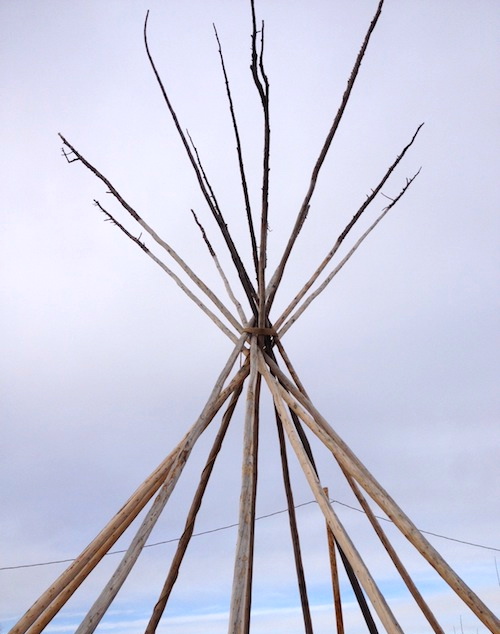 Pine Ridge, South Dakota, is the eighth largest Native American reservation in the U.S. and is home to the Oglala Sioux, one of the seven subtribes of the Lakota people. With gorgeous rolling hills and untamed wilderness, it’s no wonder why the land is held so sacred.
Pine Ridge, South Dakota, is the eighth largest Native American reservation in the U.S. and is home to the Oglala Sioux, one of the seven subtribes of the Lakota people. With gorgeous rolling hills and untamed wilderness, it’s no wonder why the land is held so sacred.
Yet, as beautiful as it is, Pine Ridge has also been deemed one of capitalism’s ‘sacrifice zones,’ because of the price the area has paid for centuries of endless capitalist expansion and Western commercialization of natural resources.
Pine Ridge Reservation is the second poorest community in America, and its state of helplessness has led to mind boggling statistics that are more in line with third world countries than the richest nation on earth – there’s an unemployment and alcoholism rate of around eighty percent, an annual per capita income of four thousand dollars, eight times the rate of diabetes than the national average and three times the rate of infant mortality.
Much of the despair among the indigenous population of North America could be attributed to having never recovered from the West’s utter evisceration of their culture, forced destruction of their people and mass genocide against their ancestors. It also doesn’t help that there is nothing for miles outside of the reservation, limiting job opportunities for Pine Ridge residents.
However, despite the multitude of problems facing a community that depends on federal funding to survive, many Sioux members have taken it upon themselves to empower the Lakota nation to a secure a brighter future. It was a honor to spend several days at Pine Ridge, and I left greatly humbled and inspired by the people I met.
Breaking the Set dedicated two episodes to shed light on the neglected plight of America’s indigenous population to cover the failure by the federal government to provide adequate social services, uphold centuries old treaties, and to allow the sovereignty of Native American communities to prosper.
Abby
***
Breaking the Set sits down with Oglala Lakota Nation Tribal Council to discuss the poor state of the reservation and the optimism the elders have about the future. Yvonne “Tiny” DeCory, BEAR program founder and youth activist, talks about her efforts to fight the suicide epidemic at Pine Ridge.
Pine Ridge Reservation Part I: Where Despair Meets Hope
***
Breaking the Set talks to Treaty Council Elder, Floyd Looks For Buffalo Hand, about the mentality of the West and the basic principles the Lakota people live by. Henry Red Cloud, 5th generation descendant of Chief Red Cloud, discusses renewable energy and its future on the reservation, as well as ancient wisdom that needs to be applied to the modern world.
Pine Ridge Reservation Part II: From Broken Treaties To Future Sustainability
***
Photo by Abby Martin | @AbbyMartin











A recent Florida trip (from the cold north to thaw out) led me to the Tampa Bay History Centre and their stunning permanent exhibit which occupies its entire ground floor; one third of the space. Here, a pocket of truth may be found among the swirling disconnected denial encircling. The truth, however, is not pretty.
It is solemnly fitting that grossly inhuman violence, a phrase that came to mind and heart through tears, serves as the foundation of the Museum, for this is a common theme in the alleged success formula of our nation. George Carlin put it bluntly, “America was founded by a bunch of slave owners who wanted to be free”.
In Florida, General Jackson and others fought three wars against the native peoples. The considerable efforts, directed by the federal government, were bolstered by the fact that the Seminoles were sheltering black slaves who sought refuge among the tribe. Jackson, attempting to flush out and “relocate” the native peoples to arid reservations to the west, conducted a litany of crimes against humanity that we should own.
The exhibits were well attended at the time. Here’s another stunner: all the other attendees sauntered through in a disconnected haze. I saw no shift of emotion; no queues of affect. I sought connection with someone, any person who got it. I felt very much alone, which amplified the compelling nature of the experience.
Upon leaving the exhibit I spoke to one of the curators present, “I feel ashamed to be white today,” and I still do. She gets it, which is why her work continues.
Abby, thank you for your commentary. It is vital that Americans better understand the foundation upon which their alleged freedoms have been constructed. Whether the effort to wake us up is worth it might be a question to wrestle with. I gave up long ago, and now simply observe, and laugh, and cry.
But, thanks to your efforts, at least we can know that there are a few among us who get it, too.
Can we organize a drop off of clothing and household effects on a regular basis? At least the children will have shoes and clothing. I have lots of things I can send, all in great condition, blankets, sheets, pillows, homewares, etc. We here in white America have so much it would be wonderful to share with our Native American Tribes.